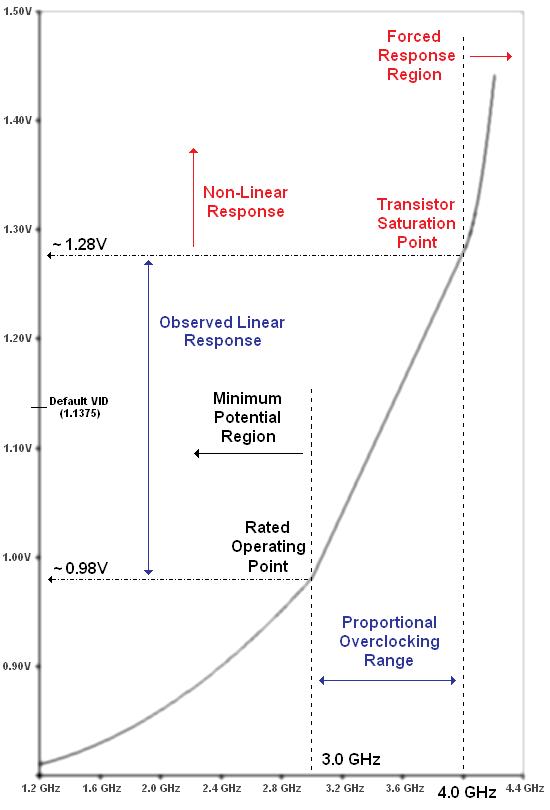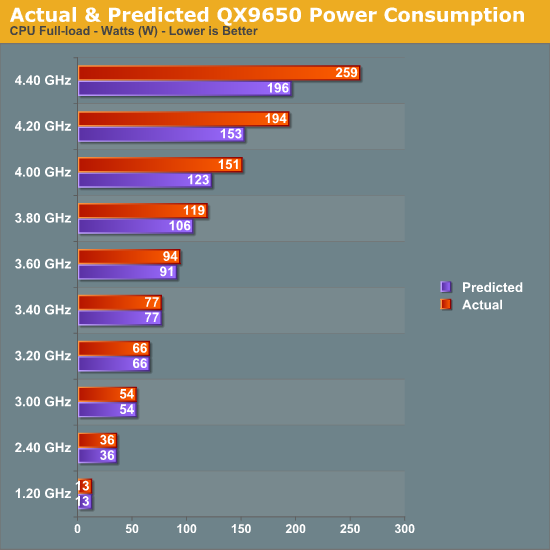Overclocking Intel's New 45nm QX9650: The Rules Have Changed
by Kris Boughton on December 19, 2007 2:00 AM EST- Posted in
- CPUs
Exploring the Limits of 45nm Silicon
During the course of our testing we made a rather interesting discovery regarding 45nm silicon scaling: a window exists in which CPU frequency responds in a highly proportional manner. Calculating this value later tells us that between 3.0GHz and 4.0GHz our processor requires ~0.3mV (0.0003V) more Vcore for each one megahertz increase in core frequency. Since our QX9650 is capable of running the stock 3.0GHz setting at only 0.98V, this means that achieving a stable 3.6GHz overclock requires 0.98V + (0.3mV/MHz)(600MHz) = 1.16V. This general trend continues all the way to about 4.0GHz where we found total stability at an amazingly low 1.28V. We cannot help but feel excited about Intel's new 45nm process, especially considering such early maturity.

Always target the higher end of the Proportional Overclocking Region
Dropping below 3.0GHz allows us a chance to experiment in the world of low-voltage (LV) and ultra low-voltage (ULV) clocking. Two point four gigahertz (2.4GHz) was possible at only 0.90V. Additionally, the lowest possible core speed that we could dial-in using the ASUS P5E3 (6 x 200MHz = 1.20GHz) had no problems maintaining stability at only 0.81V. It's interesting to note that this is also the lowest Vcore we could supply the CPU, as VID settings below 0.85000 were not available for use. As an aside, the VRM 11.0 specification, used extensively by motherboards supporting 65nm CPUs, calls for selection values down to 0.70000V.
As expected, pushing the QX9650 above 4.0GHz, although possible, also demands more Vcore than predicted by our simple scaling equation. In fact, running well in excess of this speed requires a nearly exponential increase in voltage. At this point gains are small and generally not worth the extra heat produced because of the excess power consumed. Clearly, the more efficient silicon switching that comes with better cooling is needed if we planning to go much higher. Oddly enough, for the first time in water-cooled quad-core history, we feel as though heat is not the limiting factor. Rather than push this finding aside, we decided to examine the cause a little more closely.

We start our investigation by comparing our measured processor power consumption values with those found through use of the well-known power scaling equation (shown above). The equation wonderfully predicts what we see at lower frequencies but quickly falls behind actual measured values when looking at higher speeds:

A quick check for clues as to the differences turns up one important oversight. Intel's newest power prediction equation includes an extra factor - processor capacitance. Research indicates that the capacitance associated with the transistors gates has become quite significant; possibly more so with 45nm Hi-k transistors than those made using any other previous process technology. We decided to establish the region boundary in the plot above using the point in which this effect became significant, even though the extra transistor capacitance created at higher switching frequencies begins to manifest itself as additional power required at lower processor speeds (around 3.6GHz). At 4.0GHz this additional factor accounts for 25% more power than would otherwise be predicted.
Although we cannot explain exactly why capacitance becomes such a large factor at higher speeds, average core temperature may be a factor. This would certainly help to explain why microprocessors experience such dramatic increases in switching efficiencies when super cooled. Typically, a processor needs significantly less voltage in order to run equivalent speeds under phase-change or liquid nitrogen than would be required with typical air or water-cooling. In fact, based on what we have seen, these 45nm processors may be the first of many in which overclockers find they reach silicon limits before anything else. In the past, it was comforting to know that a bigger heatsink, more powerful fan, or a better water block held the promise of a higher overclock; with 45nm this may no longer be the case.










56 Comments
View All Comments
mczak - Wednesday, December 19, 2007 - link
Granted, that's undervolted, at stock voltage it would be more like 70W instead of 54W :-).I think the criticism of intel's TDP was justified in P4 days, which really did exceed their TDP under high load. Nowadays, the TDP (at least the numbers from intel) is pretty meaningless to the end-user, since cpus with very different actual power consumption have the same rating (QX6850 and QX9650 for example...), but at least all of their cpus actually stay below the TDP.
noobzter - Wednesday, December 19, 2007 - link
I've been waiting for articles like this that delve further into OC's intricacies. Thank you for taking the time to write such an impressive piece!ahackett - Wednesday, December 19, 2007 - link
For someone like me who's fairly new to OC-ing and has been struggling to find a technical and pragmatic introductory guide to the skill, this article is like gold-dust! I look forward to the New Year when I hope to finally remove my E6300 from its temporary ASRock housing and get some decent overclocking done :)Thanks!
BradCube - Wednesday, December 19, 2007 - link
Agreed - Fantastic article. Thanks Kris :)SoBizarre - Wednesday, December 19, 2007 - link
Yeah, the rest of Anand's staff should start thinking about securing their future. Spreading some false rumors about him visiting "Tom's Hardware" office would be a good start. Add to this a couple of sexual harassment accusations and you have a winning combination that would quickly finish his career.Guys, let me spell it for you. If you don’t take action soon, you all will be F-I-R-E-D.
Vortac - Wednesday, November 20, 2013 - link
I still come back to read this article, from time to time. One of the best, really.